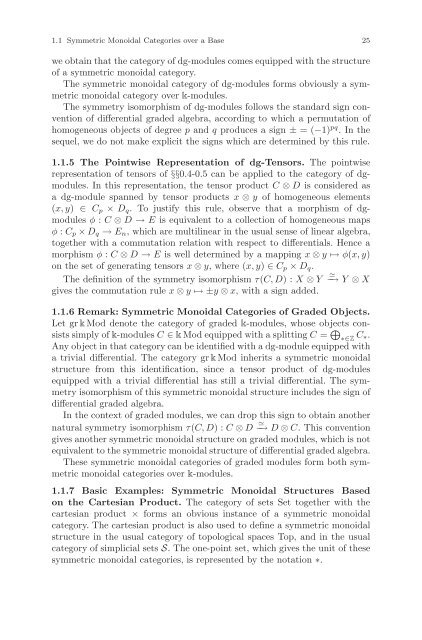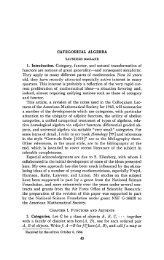Symmetric Monoidal Categories for Operads - Index of
Symmetric Monoidal Categories for Operads - Index of
Symmetric Monoidal Categories for Operads - Index of
You also want an ePaper? Increase the reach of your titles
YUMPU automatically turns print PDFs into web optimized ePapers that Google loves.
1.1 <strong>Symmetric</strong> <strong>Monoidal</strong> <strong>Categories</strong> over a Base 25<br />
we obtain that the category <strong>of</strong> dg-modules comes equipped with the structure<br />
<strong>of</strong> a symmetric monoidal category.<br />
The symmetric monoidal category <strong>of</strong> dg-modules <strong>for</strong>ms obviously a symmetric<br />
monoidal category over k-modules.<br />
The symmetry isomorphism <strong>of</strong> dg-modules follows the standard sign convention<br />
<strong>of</strong> differential graded algebra, according to which a permutation <strong>of</strong><br />
homogeneous objects <strong>of</strong> degree p and q produces a sign ± =(−1) pq .Inthe<br />
sequel, we do not make explicit the signs which are determined by this rule.<br />
1.1.5 The Pointwise Representation <strong>of</strong> dg-Tensors. The pointwise<br />
representation <strong>of</strong> tensors <strong>of</strong> §§0.4-0.5 can be applied to the category <strong>of</strong> dgmodules.<br />
In this representation, the tensor product C ⊗ D is considered as<br />
a dg-module spanned by tensor products x ⊗ y <strong>of</strong> homogeneous elements<br />
(x, y) ∈ Cp × Dq. To justify this rule, observe that a morphism <strong>of</strong> dgmodules<br />
φ : C ⊗ D → E is equivalent to a collection <strong>of</strong> homogeneous maps<br />
φ : Cp × Dq → En, which are multilinear in the usual sense <strong>of</strong> linear algebra,<br />
together with a commutation relation with respect to differentials. Hence a<br />
morphism φ : C ⊗ D → E is well determined by a mapping x ⊗ y ↦→ φ(x, y)<br />
on the set <strong>of</strong> generating tensors x ⊗ y, where(x, y) ∈ Cp × Dq.<br />
The definition <strong>of</strong> the symmetry isomorphism τ(C, D) :X ⊗ Y � −→ Y ⊗ X<br />
gives the commutation rule x ⊗ y ↦→ ±y ⊗ x, with a sign added.<br />
1.1.6 Remark: <strong>Symmetric</strong> <strong>Monoidal</strong> <strong>Categories</strong> <strong>of</strong> Graded Objects.<br />
Let gr k Mod denote the category <strong>of</strong> graded k-modules, whose objects consists<br />
simply <strong>of</strong> k-modules C ∈ k ModequippedwithasplittingC = �<br />
∗∈Z C∗.<br />
Any object in that category can be identified with a dg-module equipped with<br />
a trivial differential. The category gr k Mod inherits a symmetric monoidal<br />
structure from this identification, since a tensor product <strong>of</strong> dg-modules<br />
equipped with a trivial differential has still a trivial differential. The symmetry<br />
isomorphism <strong>of</strong> this symmetric monoidal structure includes the sign <strong>of</strong><br />
differential graded algebra.<br />
In the context <strong>of</strong> graded modules, we can drop this sign to obtain another<br />
natural symmetry isomorphism τ(C, D) :C ⊗ D � −→ D ⊗ C. Thisconvention<br />
gives another symmetric monoidal structure on graded modules, which is not<br />
equivalent to the symmetric monoidal structure <strong>of</strong> differential graded algebra.<br />
These symmetric monoidal categories <strong>of</strong> graded modules <strong>for</strong>m both symmetric<br />
monoidal categories over k-modules.<br />
1.1.7 Basic Examples: <strong>Symmetric</strong> <strong>Monoidal</strong> Structures Based<br />
on the Cartesian Product. The category <strong>of</strong> sets Set together with the<br />
cartesian product × <strong>for</strong>ms an obvious instance <strong>of</strong> a symmetric monoidal<br />
category. The cartesian product is also used to define a symmetric monoidal<br />
structure in the usual category <strong>of</strong> topological spaces Top, and in the usual<br />
category <strong>of</strong> simplicial sets S. The one-point set, which gives the unit <strong>of</strong> these<br />
symmetric monoidal categories, is represented by the notation ∗.






